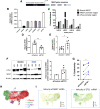NKG7 Is a T-cell-Intrinsic Therapeutic Target for Improving Antitumor Cytotoxicity and Cancer Immunotherapy
- PMID: 34911739
- PMCID: PMC8816890
- DOI: 10.1158/2326-6066.CIR-21-0539
NKG7 Is a T-cell-Intrinsic Therapeutic Target for Improving Antitumor Cytotoxicity and Cancer Immunotherapy
Abstract
Cytotoxic CD8+ T cells (CTL) are a crucial component of the immune system notable for their ability to eliminate rapidly proliferating malignant cells. However, the T-cell intrinsic factors required for human CTLs to accomplish highly efficient antitumor cytotoxicity are not well defined. By evaluating human CD8+ T cells from responders versus nonresponders to treatment with immune checkpoint inhibitors, we sought to identify key factors associated with effective CTL function. Single-cell RNA-sequencing analysis of peripheral CD8+ T cells from patients treated with anti-PD-1 therapy showed that cells from nonresponders exhibited decreased expression of the cytolytic granule-associated molecule natural killer cell granule protein-7 (NKG7). Functional assays revealed that reduced NKG7 expression altered cytolytic granule number, trafficking, and calcium release, resulting in decreased CD8+ T-cell-mediated killing of tumor cells. Transfection of T cells with NKG7 mRNA was sufficient to improve the tumor-cell killing ability of human T cells isolated from nonresponders and increase their response to anti-PD-1 or anti-PD-L1 therapy in vitro. NKG7 mRNA therapy also improved the antitumor activity of murine tumor antigen-specific CD8+ T cells in an in vivo model of adoptive cell therapy. Finally, we showed that the transcription factor ETS1 played a role in regulating NKG7 expression. Together, our results identify NKG7 as a necessary component for the cytotoxic function of CD8+ T cells and establish NKG7 as a T-cell-intrinsic therapeutic target for enhancing cancer immunotherapy.See related article by Li et al., p. 154.
©2021 The Authors; Published by the American Association for Cancer Research.
Figures







References
-
- Hellstrom I, Hellstrom KE, Pierce GE, Yang JP. Cellular and humoral immunity to different types of human neoplasms. Nature 1968;220:1352–4. - PubMed
-
- Dieckmann NM, Frazer GL, Asano Y, Stinchcombe JC, Griffiths GM. The cytotoxic T lymphocyte immune synapse at a glance. J Cell Sci 2016;129:2881–6. - PubMed
-
- Pitt JM, Marabelle A, Eggermont A, Soria JC, Kroemer G, Zitvogel L. Targeting the tumor microenvironment: removing obstruction to anticancer immune responses and immunotherapy. Ann Oncol 2016;27:1482–92. - PubMed
Publication types
MeSH terms
Substances
Grants and funding
LinkOut - more resources
Full Text Sources
Other Literature Sources
Medical
Molecular Biology Databases
Research Materials
Miscellaneous

